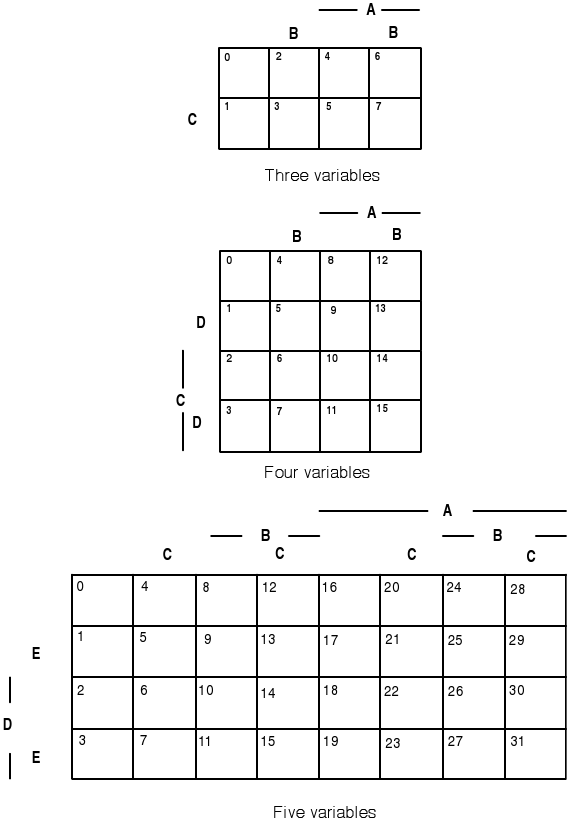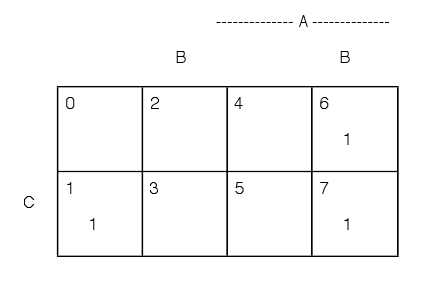To see how the fundamental partition arises naturally, consider first the partition of the
basic space produced by a single event A.
(2.1)
Ω
=
A
⋁
Ac
Now if B is a second event, then
The pair  has partitioned Ω into
has partitioned Ω into  .
Continuation is this way leads systematically to a partition by three events
.
Continuation is this way leads systematically to a partition by three events
 , four events
, four events  , etc.
, etc.
We illustrate the fundamental patterns in the case of
four events  . We form the
minterms as intersections of members of the class,
with various patterns of complementation.
For a class of four events, there are 24=16 such patterns, hence
16 minterms. These are, in a systematic arrangement,
. We form the
minterms as intersections of members of the class,
with various patterns of complementation.
For a class of four events, there are 24=16 such patterns, hence
16 minterms. These are, in a systematic arrangement,
Table 2.1. |
AcBcCcDc
|
AcB
CcDc
|
A
BcCcDc
|
A
B
CcDc
|
|
AcBcCcD
|
AcB
CcD
|
A
BcCcD
|
A
B
CcD
|

|

|

|

|

|

|

|

|
No element can be in more than one minterm, because each differs from the others by
complementation of at least one member event. Each
element ω is assigned to exactly one of the minterms by determining
the answers to four questions:
Is it in A? Is it in B? Is it in C? Is it in D?
Suppose, for example, the answers are: Yes, No, No, Yes. Then ω is
in the minterm ABcCcD. In a similar way, we can determine the
membership of each ω in the basic space. Thus, the minterms form a partition. That is, the minterms represent mutually exclusive events,
one of which is sure to occur on each trial. The membership of any minterm
depends upon the membership of each generating set  or D, and the
relationships between them. For some classes, one or more of the minterms are empty
(impossible events). As we see below, this causes no problems.
or D, and the
relationships between them. For some classes, one or more of the minterms are empty
(impossible events). As we see below, this causes no problems.
An examination of the development above shows that if we begin with a class of n events,
there are 2n minterms. To aid in systematic handling,
we introduce a simple numbering system for the minterms, which we illustrate
by considering again the four events  , in that order. The answers to
the four questions above can be represented numerically by the scheme
, in that order. The answers to
the four questions above can be represented numerically by the scheme
No ∼0 and Yes ∼1
Thus, if ω is in AcBcCcDc, the answers are
tabulated as  . If ω is in ABcCcD, then this
is designated
. If ω is in ABcCcD, then this
is designated  . With this scheme, the minterm arrangement above
becomes
. With this scheme, the minterm arrangement above
becomes
Table 2.2. |
0000
∼
0
|
0100
∼
4
|
1000
∼
8
|
1100
∼
12
|
|
0001
∼
1
|
0101
∼
5
|
1001
∼
9
|
1101
∼
13
|
|
0010
∼
2
|
0110
∼
6
|
1010
∼
10
|
1110
∼
14
|
|
0011
∼
3
|
0111
∼
7
|
1011
∼
11
|
1111
∼
15
|
We may view these quadruples of zeros and ones as binary representations
of integers, which may also be represented by their decimal equivalents, as shown
in the table. Frequently, it is useful to refer to the minterms by number.
If the members of the generating class are treated in a
fixed order, then each minterm number arrived at in the manner above specifies a
minterm uniquely. Thus, for the generating class  , in that order,
we may designate
, in that order,
we may designate
We utilize this numbering scheme on special Venn diagrams called
minterm maps. These are illustrated in Figure 2.1, for the cases of three,
four, and five generating events. Since the actual content of any minterm
depends upon the sets  , and D in the generating class, it
is customary to refer to these sets as variables. In the three-variable case,
set A is the right half of the diagram and set C is the lower half; but set
B is split, so that it is the union of the second and fourth columns. Similar
splits occur in the other cases.
, and D in the generating class, it
is customary to refer to these sets as variables. In the three-variable case,
set A is the right half of the diagram and set C is the lower half; but set
B is split, so that it is the union of the second and fourth columns. Similar
splits occur in the other cases.
Remark. Other useful arrangements of minterm maps are employed
in the analysis of switching circuits.
Minterm maps and the minterm expansion
The significance of the minterm partition of the basic space rests in large
measure on the following fact.
Minterm expansion
Each Boolean combination of the elements in a generating class may be
expressed as the disjoint union of an appropriate subclass
of the minterms. This representation is known as the
minterm expansion for the combination.
In deriving an expression for a given
Boolean combination which holds for any class  of four events,
we include all possible minterms, whether empty or not. If a minterm is empty for a
given class, its presence
does not modify the set content or probability assignment for the Boolean combination.
of four events,
we include all possible minterms, whether empty or not. If a minterm is empty for a
given class, its presence
does not modify the set content or probability assignment for the Boolean combination.
The existence and uniqueness of the expansion is made plausible by simple examples utilizing
minterm maps to determine graphically the minterm content of various Boolean combinations.
Using the arrangement and numbering system introduced above, we let Mi represent the ith
minterm (numbering from zero) and let p(i) represent the probability of that minterm.
When we deal with a union of minterms in a minterm expansion, it is convenient to
utilize the shorthand illustrated in the following.
Consider the following simple example.
Example 2.1. Minterm expansion
A key to establishing the expansion is to note that each minterm is either a subset
of the combination or is disjoint from it. The expansion is thus the union of those
minterms included in the combination. A general verification using indicator functions
is sketched in the last section of this module.







































